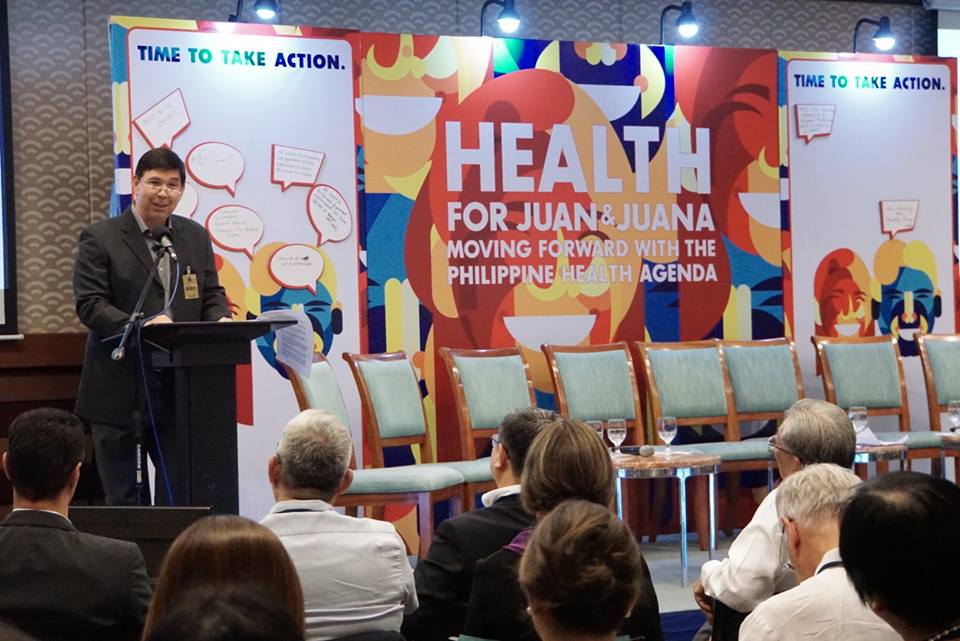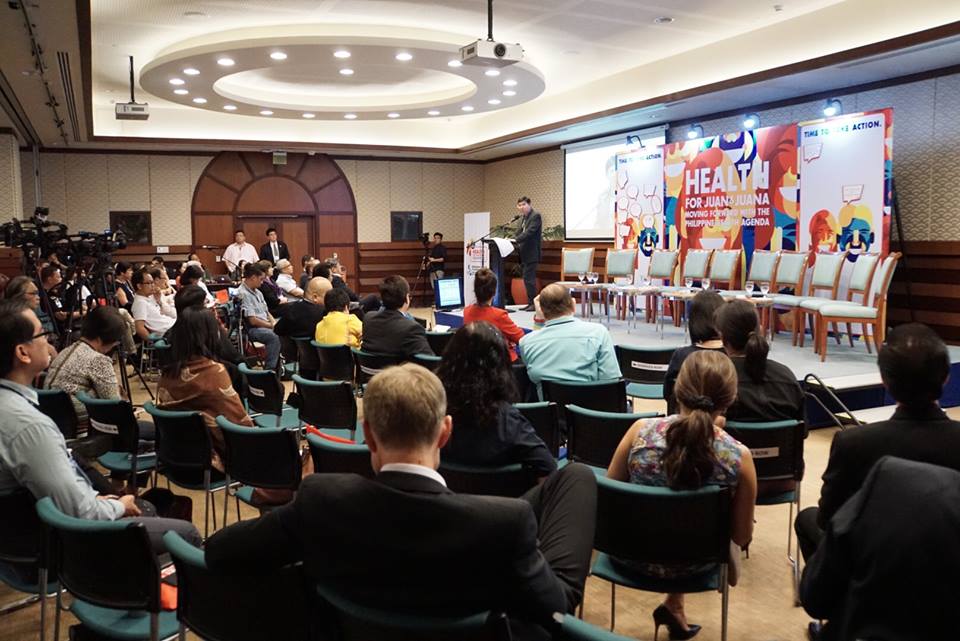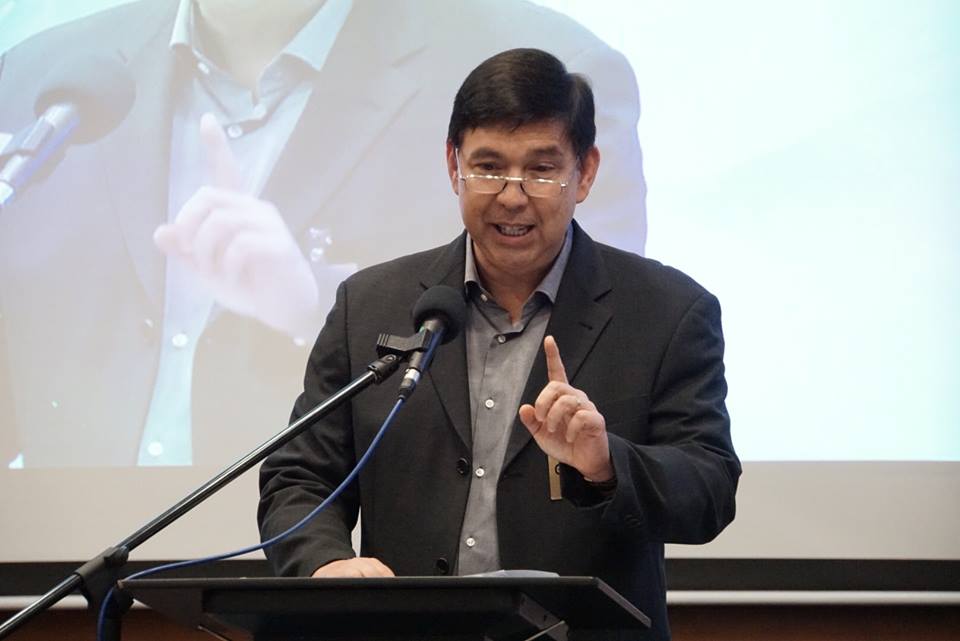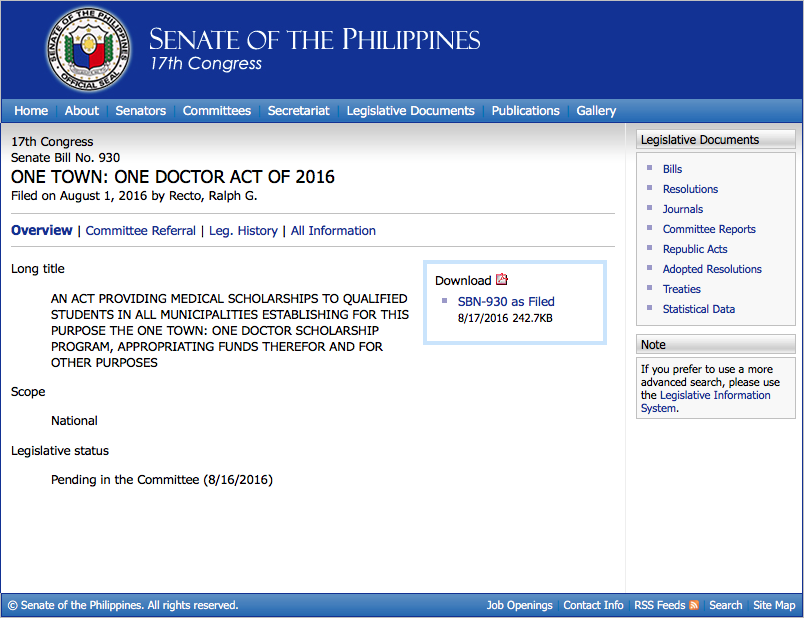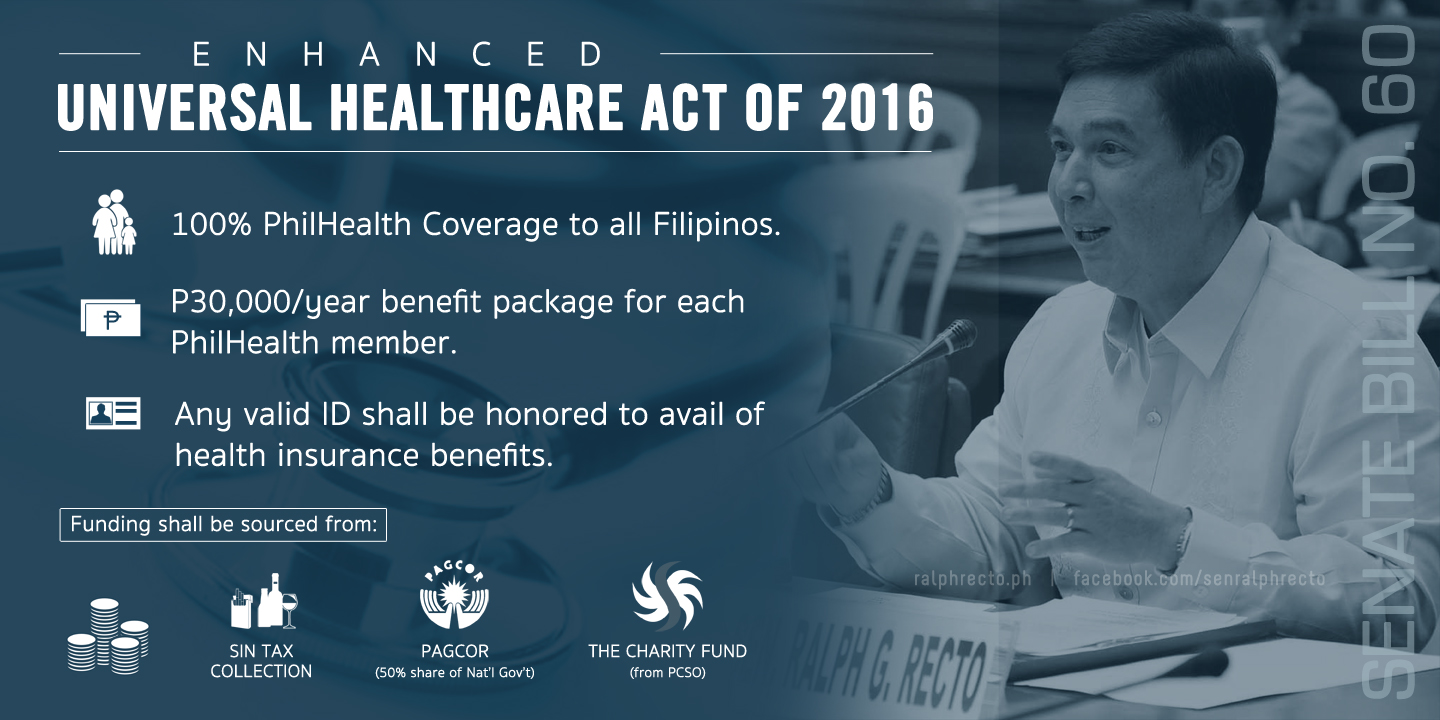Bringing Healthcare to Juan and Juana: Universal Healthcare in the Communities
Thank you. Magandang hapon po sa inyong lahat. I am happy and honored to be here today.
What I’ve noticed is that there is no universal oath that binds politicians, unlike physicians who have their famous “First, do no harm” pledge.
But if ever there will be a contest to coin one for politicos, I think “Do most harm” will be the runaway winner.
If Congress has been pilloried for causing multiple injuries to the public health system, then such an accusation is not totally undeserved.
To cite one sin, funds we infuse into the health system, even if they have sharply risen in recent years, remain inadequate.
Kulang na nga, delayed pa ang release, although this one is no fault of ours. When funds are squeezed by budgetary tourniquets, the drip-drip in allotments makes the situation worse.
Honestly, I don’t have an explanation for this ailment called attention deficit disorder on health financing.
Perhaps, lawmakers are of the healthiest of breeds, so visits to the doctors are rare. And when they get seriously sick, they are the easiest to operate on, as one joke goes.
Remember the punchline “Politicians are the easiest to operate on? There’s no guts, no heart, no balls, no brains and no spine.”
My friends: I have timed my speech to last about 20 minutes – short by senatorial standards but long enough for a doctor to see, diagnose and write prescriptions for 8 patients.
To include the open forum, our session today spans 40 minutes.
By the end of these 40 minutes, 136 babies would have been born in this land.
For 2017, our population will grow by about 1.63 million. By 2020, there will be 109.26 million of us.
In ten years, there will be 120.1 million crowding this sliver of land that typhoons hit first but to where investors head to last.
We are adding the population of one Singapore every 3 years and 4 months. In 10 years, our population will grow by 17.5 million, or the combined population of Denmark, Finland and Norway.
There are multiple ways of viewing the newborns.
Politicos might see them as future voters who must be bought. For traders, a huge market who will buy what they sell. For health professionals, a staggering multitude who must be kept healthy.
This early, we must prepare for this crush of humanity, for this is what good governance is all about: The foresight to ready the needs of the next generation, instead of displaying 20/20 hindsight on what could have, should have, would have been done.
On health, for example, one estimate pegs at 195,000 the number of hospital beds we need to install by 2027. This estimate covers existing backlogs.
But this is on the curative aspect of the health system alone.
The promotive side, like nutrition and sanitation, likewise bear huge budgetary footprints.
For example, each Filipino on the average eats 119 kilos of rice annually. Kasi nga may rice-loving gene in our DNA.
The 136 Pinoys born in the next 40 minutes will thus devour 16.1 tons of rice yearly. To produce this, we have to open up 7 hectares of land to irrigation, the size of about 166 basketball courts.
Remember, kanin lang ‘yan ng babies produced in 40 minutes.
You want the bigger picture: 17.5 million more mouths to feed means we have to ramp up rice supply by 2.1 million metric tons a year.
To achieve this, we can increase imports or irrigate more lands for rice production at a rate of 77,595 hectares – or more than three times the size of Camiguin – every year, until 2027.
But more money is needed to end the biggest cause of sickness – hunger. Our GNP number – or the Gutom na Pilipino is rising.
Lampas tatlong daang bilyon ang ating food import bill, ‘yung deklarado, hindi kasama ang smuggled, tulad ng pinuslit na pusit.
Pati sa isda, kulang na rin tayo. Labing-isang bilyong pisong halaga ang inangkat natin noong 2013, bago gawing fishpond ng mga Chinese ang karagatan natin.
Another health facility for which there is no substitute is water.
Dirty water kills more Filipinos than EJKs. And that is not fake news. That there is correlation between healthy people and clean water is not an alternative fact either.
Because Filipino men bathe twice a day, and Filipino women thrice, and the car and the dog get shampooed too, we have to source, filter, and pipe in an additional 1.1 trillion liters of water a year by 2027.
Kaya nga sa spending columns natin, ang water ay itinuturing na health spending.
And that is just a miniscule part of the total health bill.
We have not tallied the cost of training health professionals. Or wiping out the backlog in health infrastructure.
Speaking of infrastructure, doctors have been telling the couch kamotes of the land to abandon all laptops and smartphones and go out and exercise. Mine have been nagging me that stretching is as good as statins.
But for the poor, where would they run? There are no pavements to pound. Sidewalks are nonexistent and the few bangketas have been taken over by commerce.
In one Senate hearing, a DPWH representative can only give a ballpark estimate on the cost of constructing sidewalks along national roads: A minimum of P50 billion.
And we have not even begun computing future non-health expenditures, like education. On this, let me give you the bottomline:
In five years, if 120 of the 136 babies born in the next 40 minutes would knock on doors of public schools, then we should see to it that classrooms, teachers, books, and chairs are waiting for them.
Total cost: P4.5 million. Just for 120 kids. By any yardstick, a big postpartum financial headache.
In my speeches, I have been giving a snapshot of the future. This is borne out of the reality that we have a governance culture which cannot see beyond three years. Five-year plans are deemed either too long or too far into the future.
Our planning cycle follows the election calendar, which means every 1,000 days. Projects are bookended by elections.
Government programs bear “best before election” completion dates so that when inaugurated, they can be milked for reelection purposes.
This has made us experts in the tactical, and proficient on the ad hoc. We love the quick-fix, and expect Band Aid cures to mature into permanent remedies. Ours is a government of instant gratification.
So instead of embarking on grand projects that would span several administrations, we content ourselves with piecemeal construction.
The tragic result of limited vision, and planning myopia, is chop-chop development and progress in small increments.
Compounding this is the fact that at present, the only tally we’re making concerns body bags. While there are important numbers to track, the national scoreboard shows only deaths.
What it should be highlighting are projects that should improve life, especially on the health front.
This would, however, entail big and bold thinking.
Whether it is about developing human capital, like training doctors, or capital expenditures like laying rail tracks, we must have a “man on the moon” goal. I am referring to Kennedy’s vow to put a man on the moon before the 60s was over.
We must break free of the political culture which treats grandiose dreams as grandstanding.
Huwag tayo magtipid sa ambisyon. We may be in the gutter, but let us fix our gaze at the stars.
Kaya para sa akin, ‘yung planong Mindanao railway or Manila Subway, ituloy ‘yan, because it is good for a national psyche that celebrates smallness.
Isa na dito ‘yung “One Town, One Doctor” program. May nagsabi na di na daw kailangan. May narining akong puna na magastos raw.
But let us look at the facts. According to experts, the country’s public health system is grappling with a shortage of 60,000 doctors.
As result, six out of 10 Filipinos die without seeing a doctor.
We can debate on the misdistribution of physicians, as to why they congregate in urban centers. But the fact is, one in three slots in the Doctor to the Barrios has had no takers for two years in a row.
Taking these into account, the conclusion is obvious: There is a deficiency that must be plugged.
Cost has been cited as an impediment. But if you take the projected price tag of the project – which is P900 million a year at P600,000 per scholar – the fallacy of the claim emerges.
Compare the P900 million against the P6.7 billion in intelligence funds, or the P17.9 billion in travel expenses of bureaucrats this year.
The P900 million is also less than 1 percent of the P102 billion we allocated this year in pension for retired soldiers and policemen.
If the two houses of Congress can have an annual budget of P15 billion, and such is seen as an expense vital to democracy, then why should medical scholarships be disparaged as a nonessential luxury?
Gusto niyo pa ng isang halimbawa? Central Bank has requested P150 billion in additional capitalization, a request Congress will likely accede to.
Anong ibig sabihin nito? That banks are too big to fail and medical scholarships are too big to fund?
For those who think the cost is too big, here’s a point to ponder: The most recent figures show that the Philippine Military Academy spends P4.2 million to produce one graduate.
In contrast, we will be spending half that amount to produce one graduate of what would virtually become the “Philippine Medical Academy”.
The proposed “One Town, One Doctor” law requires government to choose one medical student scholar per town. This is not an unconditional entitlement. The quota is linked to merit. There are academic standards to be hurdled.
To qualify, an applicant must belong to the upper 30 percent of a graduating class of any pre-Med course and have been accepted to medical school.
The scholarship will cover tuition, laboratory, miscellaneous fees, and all school fees; textbooks, supplies and equipment; clothing and uniform allowances; traveling, subsistence and living expenses.
If no one from a town qualifies for the program, the allotted slot may be assumed by a scholar coming from another town in the same province.
The scholarship is linked to the condition that when the scholar becomes a doctor, he will go back to his town to serve for four years.
In short, this is a “galing sa bayan, tungo sa bayan” scheme of producing doctors.
We pick from among the town’s best and brightest, finance his medical studies, and when he becomes a doctor, he repays it by serving his own people.
Ang isang reservation na nabasa ko sa One Town, One Doctor ay baka lumobo raw ang payroll ng pamahalaan.
Here’s the lowdown on this: Government payroll is, hold your breath, already P1 trillion a year. On a daily basis, that’s P2.7 billion. But that already includes pension of retired soldiers and policemen.
The DOH share of this is a measly three percent.
And since when have doctors been deemed nonessential and decorative? They are in short supply, in contrast to the surplus of elected officials.
Every three years, we spend billions of pesos to hire, in a costly procedure called elections, 12 senators, almost 300 congressmen, 81 governors, 1,634,776 provincial board members, 13,540 councilors, 294,252 barangay officials.
And how many doctors are we deploying under this bill? 1,500.
In fact, the annual medical scholarship fund of P900 million contemplated under this measure is less than one-tenth of the average P10 billion annual budget of the Comelec over the past seven years.
Without doubt, this program is administratively and financially feasible.
Yes, many implementation details need ironing out. So your suggestions are welcome in order to improve this bill. One thing I learned in legislation is birth pains are lessened if there are more midwives.
I can only hope that when the first batch of One Town, One Doctor scholars pass the medical board, they will be acknowledged, even at a decibel level below how society toasts even the near Bar flunkers.
For this is what our overlitigated but undermedicated society needs—more doctors who will do no harm.
This bill is not a cure-all pill. Our health system needs a bigger cocktail of interventions to address deficiencies.
This is why I have proposed several bills in the Senate aimed at addressing the backlogs and lack of funds in our health system.
One of which is my own Senate Bill No. 60 whose primary aim is to provide universal healthcare coverage to all Filipinos. The principle behind this measure is that if you are a citizen of this country, you will be qualified to avail of health benefits, regardless if you have a Philhealth identification card or not.
The bill also proposes to improve the benefit packages being offered by Philhealth by increasing the amount of benefits to lessen the out-of-pocket expenses on the part of the members. Improving the benefit packages would also entail the inclusion of preventive and promotive health services to minimize the chances of confinement and to encourage a healthy lifestyle among the population.
We will also introduce substantive amendments to the Pagkaing Pinoy Para sa Batang Pinoy Bill which is being deliberated right now in the Senate, to further address the problem of hunger and undernutrition among Filipino children, by expanding the coverage of health, nutrition and feeding program from conception to childhood.
These and many more are part of our efforts in the Senate to bring universal healthcare to the communities. Feel free to share us your inputs so that we can come up with pieces of good legislation that are encompassing, effective and affordable for the Filipino people.
Maraming salamat.
RELATED ARTICLES:
-
22 NOV 2016: 626 ‘Doctor to the Barrios’ slots unfilled, nalagasan pa—Recto
-
22 NOV 2016: Just 1 in 3 ‘Doctors to Barrios’ slots taken, Recto bats for ‘1 town, 1 doctor’ scholarships
-
12 NOV 2016: Action urged on thousands of govt nurses facing endo
-
26 SEP 2016: As chronic malnutrition worsens, Recto pushes for national child health program
-
08 SEP 2016: Gov’t plans to slash number of rural doctors by half, nurses by one-third
-
27 AUG 2016: Using P40B gaming income is good Rx to boost anemic gov’t budget for meds
-
31 JUL 2016: Recto files ‘1 town, 1 doctor’ MD scholarship bill
-
23 JUL 2016: Use PCSO income to boost anemic gov’t drug spending of 70 centavos per pinoy daily


